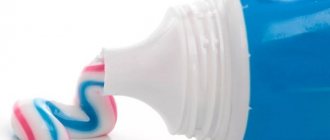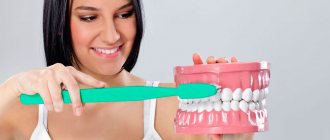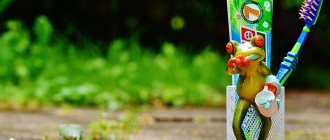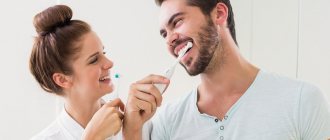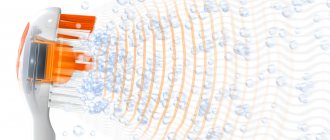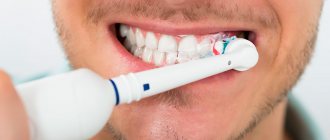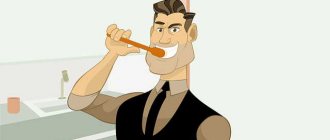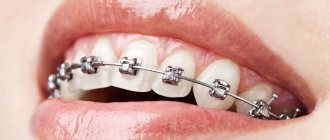Ksenia Kotova editor of Dental Magazine
From time immemorial, humanity has been concerned about oral hygiene. Studying the remains of teeth that are 1.8 million years old, archaeologists have determined that the small dimple-shaped depressions on them are the result of the impact of a primitive toothbrush. Originally it was just a tuft of grass that people used to rub their teeth to get rid of stuck food fibers. Over time, a tool for cleaning teeth has become not only a hygiene item, but also an indicator of the status of the owner. For example, in Japan, China and Ancient India it was made from precious metals.
It is known that in ancient times people used salt, chalk or soot and rubbed them into their teeth using their fingers or a piece of cloth.
Already in 3500 BC. e. the inhabitants of Babylon, Greece and Rome made special chewing sticks from fragrant branches of the mastic tree. The twig was chewed from one end, leaving a pointed edge and using it as a toothpick.
Rice. 1. Chewable licorice root stick.
In ancient India, teeth were cleaned with a mixture of charcoal, gypsum, resin and roots of medicinal plants. In India, chewing twigs made from the branches of the neem tree are still sold.
Rice. 2. A stick for cleaning teeth made from neem tree branches.
The Egyptians, and especially noble nobles, whitened their teeth enamel with powder made from raisins, myrrh and frankincense. Crushed ram's horn was used as an abrasive.
The toothbrush has come a long way since its inception, and the history of its development is fascinating and amazing!
Researchers believe that dental instruments similar to those used around the world today were invented in China in 1498. Its bristles were stiff and consisted of coarse hairs taken from the back of the pig's neck. The handles to which the bristles were attached were made of bones or bamboo.
Rice. 3. China is considered the birthplace of the toothbrush.
In Russia in the 16th century, similar “tooth whisks” were also known, consisting of a wooden stick and a brush made of pork bristles. These inventions were delivered to Russia from Europe.
Rice. 4. The “toothbrush” accompanied every self-respecting boyar at royal feasts.
Under Peter I, the royal decree ordered that the toothbrush be replaced with a cloth and a pinch of crushed chalk. In the villages they continued to rub their teeth with birch charcoal, which whitened the teeth.
The very first toothbrush: what was it like?
In this article
- The very first toothbrush: what was it like?
- When did toothbrushes become popular?
- In what year was the modern brush invented?
- The first electric toothbrush: when did it appear?
- Modern models: variety of choice
People have been thinking about oral hygiene long before there was a toothbrush. This is confirmed by archaeological excavations, during which numerous devices for cleaning teeth were found. For example, one such device was a wooden stick, one edge of which was pointed, and the other was used for chewing to remove plaque. These “brushes” were made from trees rich in essential oils.
The first toothbrushes were twigs, tufts of grass, bird feathers, animal bones and even porcupine quills.
The evolution of the toothbrush: from a wooden stick to smart gadgets
On February 24, 1938, Oral-B released a brush that replaced animal bristles with synthetic nylon fibers. That is, 83 years ago a modern toothbrush appeared, which each of us has in the bathroom. We became interested in tracing the evolution of the toothbrush: how humanity came from a bamboo stick with a tuft of pig bristles to electric and ultrasonic gadgets. As it turns out, the history of the toothbrush is actually interesting.
Advice from Umico
When choosing a toothbrush, pay attention to the degree of hardness: the bristles can be soft, medium or strong. The length of the cleaning head of the toothbrush should be at least 3 cm and the width at least 1 cm. Pay special attention to the handle: a flexible connection to the head allows you to regulate the pressure on the teeth, thereby protecting the enamel from damage. It is recommended to change your toothbrush at least once every three months. You can find a large selection of different toothbrushes at Umico Market.
Colgate toothbrush
Children's toothbrush Oral-B
Xiaomi Mi Electric Toothbrush
Wooden sticks, porcupine quills, a toothbroom - this is how the “brush” was changed
3500 BC e. – chewing stick
Archaeologists are confident that people took care of oral hygiene long before our era - this was shown by an examination of dental remains that are more than 1.8 million years old. Small curved dimples on them are traces of the ancestor of the modern brush. It was a wooden stick, softened at one end and sharpened at the other. Such sticks were found in tombs. The sharp end was used to remove food debris, and the other end was chewed to get rid of plaque. These “brushes” were made from special types of wood that contain essential oils and have disinfectant properties.
Ancient times - toothpicks
The ancient Greeks and Romans used toothpicks. They were made not only from wood, but also from bone, horn, and metal ones were richly decorated. For example, Pliny the Younger (an ancient Roman statesman, c. 61 – c. 114) did not recommend brushing your teeth with a vulture feather to avoid bad breath, but recommended porcupine quills. Roman patricians often had special slaves who were responsible for the cleanliness of their masters' teeth. Already in the 11th century, the theologian Abu Hamid al-Ghazali created instructions for using a toothbrush, which in general terms are still relevant.
1498 - the first brush similar to the modern one
It was invented in China, and the brush looked like this: tufts of pork bristles were attached to the end of a bamboo or ivory stick. Instead of paste, we used ground eggshells, ginseng extract, pine needles and salt. The invention was quickly brought to Europe by traders, but it did not take root there immediately. In general, the toothbrush was initially an outcast: in Europe it was considered indecent to use it. For several centuries, Europeans cleaned their teeth with a cloth and toothpick sticks made of gold, copper or goose feathers.
16th century – “tooth broom”
During the time of Ivan the Terrible, at the end of the feast, the boyars took a “tooth broom” from the pocket of their caftan - a wooden stick with a tuft of pork bristles. Only noble boyars could afford a toothbroom. The common people only had access to birch charcoal, which perfectly whitened their teeth, but after it they had to rinse their mouth for a long time and thoroughly.
17th century – toothbrush held in high esteem
The opinion about the toothbrush changed only in the middle of the 17th century. This happened thanks to the book of the French dentist Pierre Fauchard , “The Dentist-Surgeon, or a Treatise on Teeth.” In his scientific work, Fauchard criticized the then prevailing opinion that the cause of dental diseases were some mysterious “tooth worms.” Fauchard argued that teeth must be brushed, and every day. True, in his opinion, horsehair, which was used in Europe to make bristles, was too soft and could not clean teeth efficiently, and pig bristles, on the contrary, severely damaged the enamel of teeth. There was no other alternative then.
1780 – first industrial production of toothbrushes
The creator of the modern toothbrush is considered to be the Englishman William Addis, who came up with his invention... in prison, where he ended up because of his participation in a riot. According to legend, Addis got the idea for a toothbrush while watching a prison janitor at work. He used a broom to sweep dirt out of hard-to-reach places, and William thought that something similar could be done to remove food debris between his teeth (the cloth with salt and soot that they used back then did not cope with the task). He took a bone from his plate, made a hole, asked for pig bristles - and the prototype of the toothbrush was ready. Upon his release, William Addis continued the business: he hired women who made brushes at home, then created the Addis factory, which very quickly made brushes popular throughout London. By the way, the company still exists and produces household goods.
Photo: Lewis Weeks, Library of Congress archives
Eugenia Lampron spent 9 years threading bristles into toothbrushes in the kitchen of her home, 1912.
1885 – mass production of brushes in Europe and the USA
Photo: “Your Blog”
Napoleon's toothbrush
Their handle was made of bone, and the brush itself was made of Siberian boar bristles. Later, this design was considered unsuccessful - the brush did not dry well, and there was a cavity inside the bristles where bacteria could multiply. The eminent French microbiologist Louis Pasteur hypothesized that the cause of many dental diseases are microbes and viruses. And it is most comfortable for them to reproduce in the humid environment of natural bristles. Dentists suggested boiling toothbrushes every day, but this quickly rendered them unusable. We had to wait another half century until nylon was invented by specialists from the American chemical company Du Pont.
1938 - the first toothbrush with nylon hairs
This was truly a breakthrough. On February 24, 1938, Oral-B released a brush that replaced animal bristles with synthetic nylon fibers. Its advantages over bristles or horsehair were obvious: nylon is lightweight, durable, elastic, and moisture-resistant. Nylon bristles dried much faster, so bacteria did not multiply as quickly.
Oral-B 1+1 toothbrush set
Toothbrush Oral-B 3-Effect Maxi Clean
Oral-B antibacterial toothbrush
1939 - the first electric toothbrush
The invention was invented in Switzerland. It was a stationary device with an electric motor. It was developed for people with impaired fine motor skills, or for those who had braces installed on their teeth.
1960 - the first cordless automatic brush from General Electric
This brush could be used by everyone without exception. The device did not operate from the mains, but was powered by a built-in battery.
1992 – the first ultrasonic brush was patented
The point of such a brush is that it generates ultrasound, which helps remove plaque and neutralizes harmful bacteria in the oral cavity.
From 1963 to 2000, more than 3,000 toothbrush models were patented around the world.
First, devices with a rotating head were created, then the head began to perform reciprocal rotating movements. Brushes with a timer and replaceable attachments were produced. Even the bristles began to be covered with a special erasable pigment, which informed the owner about the need to replace the nozzle. Now smart brushes can be connected via Bluetooth to a smartphone, and, thanks to built-in motion and pressure sensors, the application will help you not to miss a single area of the oral cavity, and will also analyze the effectiveness of your actions when brushing your teeth.
Check out all the possibilities of electric brushes at Umico Market
Electric toothbrush ORAL-B with built-in timer.
An electric toothbrush has been clinically proven to clean your mouth more effectively than a regular toothbrush. The built-in timer will notify you when the two-minute brushing procedure recommended by dentists is completed.
Philips sonic toothbrush.
A 30-second timer lets you know when each quadrant of your mouth has finished brushing and signals you to move on to the next, resulting in more thorough brushing.
Colgate Pulsating Electric Toothbrush.
The soft-bristled heads gently massage your gums without damaging them and produce up to 20,000 sound vibrations per minute. Unique multi-directional brush movements help remove more plaque and clean the oral cavity as effectively as possible.
Find out more with Umico Market. And at the same time – make pleasant and useful purchases!
Share
If you are not with us yet, the buttons to download the application are here
Everything in one application!
0987
When did toothbrushes become popular?
At the end of the 15th century, the Chinese invented a device that was much more like a modern toothbrush. It looked like a bamboo stalk with the stiff bristles of a wild boar attached to it. The toothbrush was used dry - without paste or powder.
Gradually, the invention of the Chinese began to spread throughout the world and even reached our country. During the time of Ivan the Terrible, dental brooms were popular, which looked like a wooden stick with bristles at the end.
In the mid-17th century, a book by the French dentist Pierre Fauchard appeared, which described dental diseases and methods for their removal. In his book, the dentist recommended brushing your teeth daily, which contributed to the rise in popularity of the toothbrush.
The appearance of the first brushes in Russia
In Russia, the first devices for cleaning teeth appeared during the reign of Ivan the Terrible. A toothbrush entered Russia from China. It was the same bamboo stick with boar bristles attached, but the Russians didn’t really like the stiffness of natural boar bristles, and they began to use hairs from the horse’s tail.
Only some noble nobles used a toothbrush, or, as it was called then, a “toothbroom”, while the rest got along just fine without this device. Poor peasants brushed their teeth with charcoal, often made from birch, which not only helped get rid of plaque, but also perfectly whitened tooth enamel.
When the reins of power passed to Peter I several generations later, he gave the order to stop using a “toothbroom” with natural bristles and replace it with a cloth with a pinch of crushed chalk. This happened at a time when Louis Pasteur suggested that the cause of all diseases lies precisely in the toothbrush, since there is always a humid environment where microorganisms actually multiply, which provoke various diseases. Villagers and servants still used charcoal.
In what year was the modern brush invented?
The very first modern brush appeared in 1780. It was then that the Englishman William Addis began the industrial production of these hygiene products.
The very first brushes had natural bristles, which did not dry well and contributed to the growth of bacteria.
The world really began to use toothbrushes en masse when a brush with nylon bristles appeared. It dried quickly, accumulated bacteria much more slowly than natural ones, and was lightweight and durable, due to which it quickly gained popularity. Oral-B was the very first nylon model.
Initially, ordinary nylon was used for production, which severely scratched teeth and gums, but soon a special “soft” nylon was developed, and the toothbrush became much more comfortable to use.
How did you brush your teeth before using a toothbrush?
People began taking care of their teeth long before our era. Initially, it was a simple bunch of grass, with which the ancient inhabitants tried to clean their teeth of food debris. This device was not entirely convenient, and also ineffective. Some peoples used wooden sticks, the end of which was chewed to make something like a brush, after which they cleaned their teeth of plaque with this device.
They tried to clean their teeth from food debris with a specially pointed end of a wooden stick (something like a modern toothpick). For this purpose, only those tree species were used that contained essential oils that had not only a pleasant smell, but also antibacterial properties. This historical fact is confirmed by historians who examined the written materials of Ancient Egypt.
Some African aborigines still use toothbrushes that they make themselves from salvadoran branches. In some American countries, white elm branches were used for this purpose. Some peoples did not use such sophisticated devices for cleaning teeth; they chewed resin and beeswax, which, at least a little, removed food debris and plaque.
The first electric toothbrush: when did it appear?
The nylon toothbrush continued its evolution into the 20th century. So, at the end of the 30s, the first electric brush was invented in Switzerland, which worked from the mains. Mass production of electric brushes began in 1960 with the release of the Broxodent model. The manufacturer, the pharmaceutical company Bristol-Myers Squibb, positioned it as a hygiene product for “special” situations. It was planned that the brush would be used by people with impaired motor skills and those who wear braces.
But the device turned out to be so popular and effective that a year later the General Electrics company released a battery-powered model for mass use, and everyone began to use electric brushes.
Toothbrush hardness levels for the oral cavity
When choosing a toothbrush, you need to pay attention to the degree of stiffness of the bristles.
In general, experts distinguish between five levels of hardness of oral care devices:
- Sensitive – the softest type of bristles. The device is intended for children or adults suffering from diseases of the gums and hard dental tissues.
- Soft – a soft toothbrush, recommended for bleeding gums, pregnant women and users with diabetes.
- Medium – a toothbrush with a medium degree of hardness. The most popular device among adults without obvious signs of oral disease.
- Hard – a device with hard bristles, which is an alternative solution for smokers and users with increased formation of dental plaque of various etiologies.
- Extra-hard – marking of a specialized toothbrush that is used to clean dentures, braces and other fixed structures in the oral cavity
Modern models: variety of choice
Modern people have access to both traditional and electric brushes. Recent ones are becoming more advanced and technologically advanced every year. Modern models clean teeth using sound and ultrasonic waves, allow you to adjust the degree of pressure, operate in several modes, and are equipped with a built-in timer to control the cleaning time.
Dentists note that an electric brush can remove more plaque and make it easier to clean hard-to-reach areas. In addition, the use of the device increases the duration of cleaning, which has a positive effect on its quality.
If you are unsure which brush to choose for daily use, you should consult your dentist. The doctor will check the condition of your teeth and gums and assess whether they can provide effective and safe care.
Types and classification
The modern market offers a wide range of products for cleaning the oral cavity. It’s easy for a buyer to get lost in the variety of toothbrushes.
Getting to know the most popular types of toothbrushes, their advantages and disadvantages will allow consumers to make the right decision and choose the most suitable device for cleaning the oral cavity.
Read about arthritis of the maxillofacial joint and its symptoms and treatment with antibiotics. What ointment to use when treating gums? More details here.
Bamboo
Bamboo toothbrushes are usually classified as environmental products. The bristles of the device are made of natural bamboo fiber.
Unlike toothbrushes made of nylon fibers, the bamboo analogue boasts the finest bristles coated with substances to prevent diseases and improve the general condition of the oral cavity.
Bamboo toothbrushes have several obvious benefits. Among them are the following:
- Gentle care. Bamboo toothbrushes are an alternative solution for people with sensitivity. The device gently and effectively cleanses the oral cavity.
- Disinfectant properties. Bamboo has powerful disinfectant properties; the plant is included in many Chinese medicines.
- Hypoallergenic. The toothbrush is suitable for small children and people with allergies. Moreover, a bamboo brush can be used without toothpaste.
- Variability. Manufacturers offer bamboo brushes with additional coating on the fibers, which have beneficial properties.
Note . Gold spraying has an anti-inflammatory effect, silver particles have an antibacterial effect, charcoal spraying whitens teeth and eliminates unpleasant odors, and jade actively fights tartar.
However, users of bamboo oral toothbrushes note minor disadvantages of the device. We are talking about the primitive design and excessive flexibility of the device handle.
Electrical
Many users, when choosing an oral care product, prefer the most interesting new products from manufacturers, for example, an electric toothbrush.
Unlike classic toothbrushes, the electric device is equipped with a special head, which automatically performs rotational movements, eliminating plaque, food debris and harmful microorganisms.
Note . Electric toothbrushes produce up to 48 thousand strokes per minute.
Electric toothbrushes have a number of winning advantages. Among them are the following:
- Save time. When using a regular toothbrush, the procedure for cleaning the oral cavity takes up to 5 minutes, while an electric device copes with the task within 2 minutes.
- Efficiency. Electric oral cleansers are more effective at removing plaque and bacteria from the surface of teeth. According to a Cochrane study, using an electric toothbrush reduced gingivitis bacteria by 12% over two months.
- Safety. Electronic toothbrushes are equipped with a special sensor that controls the force of pressure on the surface of the teeth. The technology allows you to minimize the abrasion of enamel and damage to the gums.
As for the disadvantages, buyers note the fairly high cost of the toothbrush and the need to regularly charge oral care devices.
At the same time, experts note that an electric toothbrush is contraindicated for users wearing veneers or crowns. Vibrations of the device contribute to micro-destruction of prostheses.
Ultrasonic
Just a few years ago, it was difficult for people to imagine an ultrasonic toothbrush for cleaning the oral cavity. But progress does not stand still, and modern manufacturers are actively producing nano-brush.
The principle of operation of the device is simple; the toothbrush fights plaque and bacteria even in hard-to-reach places thanks to ultrasound radiation, inaccessible to human hearing. The bristles of the device are capable of producing up to 100 million rotations per minute.
The main advantage of the ultrasonic novelty is its high efficiency. Ultrasound performs its functions much more effectively than the components of toothpastes; the device reduces gum bleeding and has an antimicrobial effect.
Among the disadvantages of an ultrasonic toothbrush, it is necessary to note its cost, which is several times higher than the prices of other types of devices for cleaning the oral cavity. Moreover, the device is contraindicated during pregnancy and lactation.
